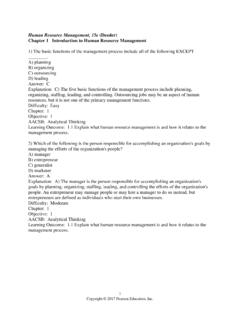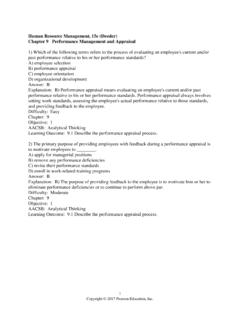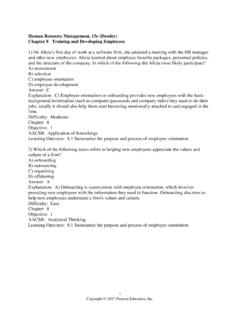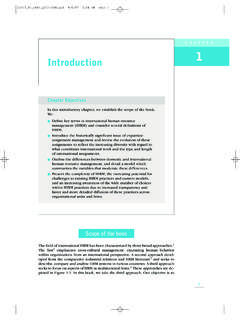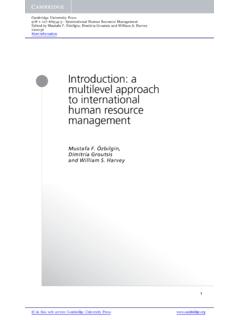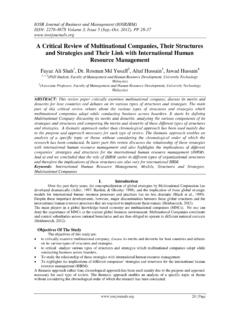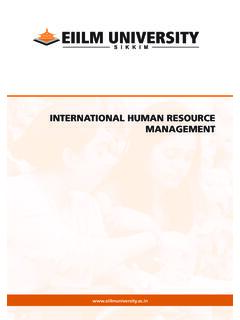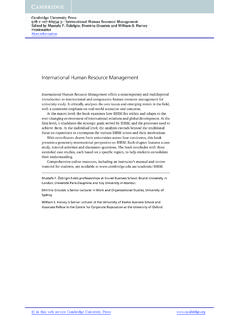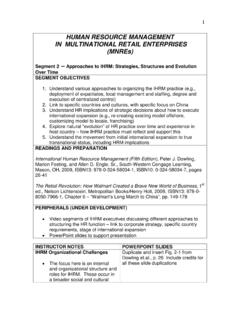Transcription of Human Resource Management, 15e (Dessler) …
1 1 Copyright 2017 Pearson Education, Inc. Human Resource management , 15e ( dessler ) Chapter 17 Managing Global Human Resources 1) Which of the following terms refers to the Human Resource management concepts and techniques employers use to manage the challenges of their international operations? A) work councils B) international Human Resource management C) power distance D) codetermination Answer: B Explanation: B) international Human Resource management is the Human Resource management concepts and techniques employers use to manage the Human Resource challenges of their international operations.
2 Difficulty: Moderate Chapter: 17 Objective: 1 AACSB: Analytical Thinking Learning Outcome: List the HR challenges of international business. 2) international Human Resource management (IHRM) focuses on three main topics. Which of the following is NOT one of them? A) comparing Human Resource management practices B) managing Human resources in global companies C) domestic company partnerships D) managing expatriate employees Answer: C Explanation: C) Comparing Human Resource management practices, managing Human resources in global companies, and managing expatriate employees are the main topics of IHRM.
3 Difficulty: Hard Chapter: 17 Objective: 1 AACSB: Analytical Thinking Learning Outcome: List the HR challenges of international business. 3) The most significant HR challenge faced by international firms is the language barrier. Answer: FALSE Explanation: Vast distances increase the challenges for an international firm. However, language is not necessarily the biggest issue. Cultural, political, legal, and economic differences among countries create challenges for global firms. Difficulty: Easy Chapter: 17 Objective: 1 AACSB: Analytical Thinking Learning Outcome: List the HR challenges of international business.
4 2 Copyright 2017 Pearson Education, Inc. 4) international Human Resource management (IHRM) is the Human Resource management concepts and techniques employers use to manage the Human Resource challenges of their international operations. Answer: TRUE Explanation: international Human Resource management (IHRM) is the Human Resource management concepts and techniques employers use to manage the Human Resource challenges of their international operations. Difficulty: Easy Chapter: 17 Objective: 1 AACSB: Analytical Thinking Learning Outcome: List the HR challenges of international business.
5 5) Geert Hofstede called the extent to which less powerful members of institutions accept and expect an unequal power distribution _____. A) masculinity B) individualism C) power distance D) tolerance for ambiguity Answer: C Explanation: C) A study by Professor Geert Hofstede identified international cultural differences. For example, Hofstede says societies differ in power distance, which is the extent to which the less powerful members of institutions accept and expect an unequal distribution of power. Difficulty: Easy Chapter: 17 Objective: 2 AACSB: Analytical Thinking Learning Outcome: Illustrate with examples how intercountry differences affect HRM.
6 6) According to research, which of the following is a greater concern to Chinese managers than United States managers? A) getting tasks accomplished efficiently B) keeping a distance from subordinates C) enforcing a firm's policies and regulations D) maintaining a harmonious work environment Answer: D Explanation: D) Although many managers endorse performance-based pay in China, other employers, to preserve group harmony, make incentive pay a small part of the pay package. And, as in other parts of Asia, team incentives are advisable. Difficulty: Moderate Chapter: 17 Objective: 2 AACSB: Analytical Thinking Learning Outcome: Illustrate with examples how intercountry differences affect HRM.
7 3 Copyright 2017 Pearson Education, Inc. 7) In which country do individuals have a high acceptance of unequal power distribution between managers and subordinates? A) Mexico B) Hong Kong C) Sweden D) United States Answer: A Explanation: A) Power distance represents the extent to which the less powerful members of institutions accept and expect an unequal distribution of power. Studies show that acceptance of such inequality is higher in some countries (such as Mexico) than in others (such as Sweden). Mexican workers expect managers to keep their distance rather than to be close, and to be formal rather than informal.
8 Difficulty: Moderate Chapter: 17 Objective: 2 AACSB: Analytical Thinking Learning Outcome: Illustrate with examples how intercountry differences affect HRM. 8) Of the countries listed below, in which one do production workers receive the lowest hourly wage? A) United States B) Philippines C) Germany D) Taiwan Answer: B Explanation: B) Hourly compensation costs (in dollars) for production workers range from $ in the Philippines to $ in Taiwan, $ in the United States, $ in Germany, to $ in Norway. Difficulty: Moderate Chapter: 17 Objective: 2 AACSB: Analytical Thinking Learning Outcome: Illustrate with examples how intercountry differences affect HRM.
9 4 Copyright 2017 Pearson Education, Inc. 9) _____ are formal, employee-elected groups of worker representatives that meet monthly with managers to discuss topics affecting the employees. A) Bargaining units B) Work councils C) Mediation groups D) Employee boards Answer: B Explanation: B) In many European countries, work councils replace the worker- management mediations typical in firms. Work councils are formal, employee-elected groups of worker representatives that meet monthly with managers to discuss topics ranging from no-smoking policies to layoffs.
10 Difficulty: Easy Chapter: 17 Objective: 2 AACSB: Analytical Thinking Learning Outcome: Illustrate with examples how intercountry differences affect HRM. 10) In many European countries, _____ replace the union-based worker- management mediations typical in the A) HR managers B) corporate attorneys C) work councils D) bargaining units Answer: C Explanation: C) In many European countries, work councils replace the worker- management mediations typical in firms. Work councils are formal, employee-elected groups of worker representatives that meet monthly with managers to discuss topics ranging from no-smoking policies to layoffs.

